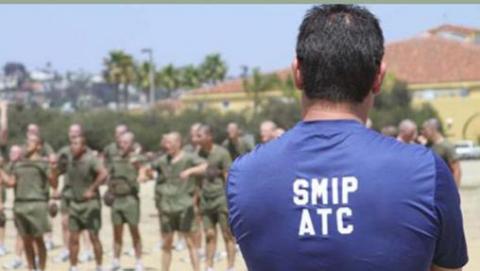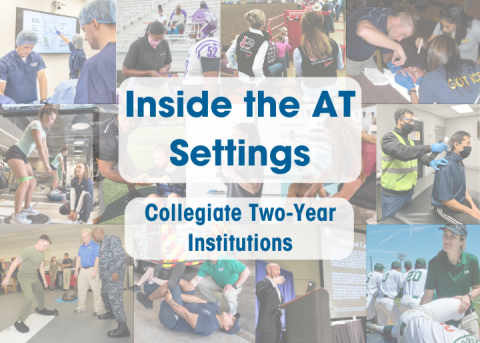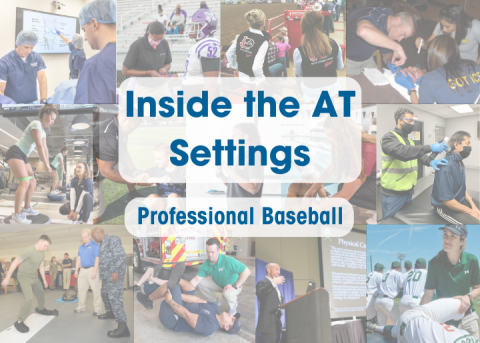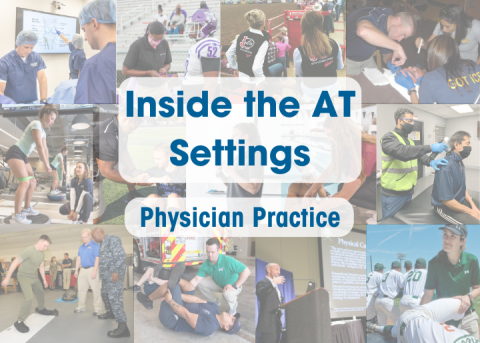January 20, 2016 by JordanG

By the NATA Committee on Practice Advancement Military Workgroup
Musckuloskeletal (MSK) injuries are the single largest impediment to operational readiness in the military setting. Over 600,000 services members sustain a MSK each year, resulting in over 2.2 million medical encounters. 1-3 Along with the impact on readiness, MSK are the largest contributor to time loss and account for over $550 million in direct care patient costs per year.
Certified Athletic Trainers (AT’s) have been utilized in the armed services for over 50 years. Originally military ATs worked at the United States Military, Naval, Air Force, and Coast Guard Academies in the traditional roles with sports teams. The physical, physiological, and psychological demands of more than 14 years of sustained combat has forced our military to take a new look at the human dimension aspect of caring for Warfighters. Repeated deployments with short dwell times have taken a hard toll on our Warriors. Forward thinking units have been employing the sports medicine team model to help improve fitness and performance while decreasing MSK injuries. Use of this integrated, multidisciplinary approach to care has now spread across all branches of the military, producing positive changes in health, wellness, fitness and performance. ATs have been shown to be a vital part of these sports medicine teams.
AT’s in the military setting are now providing care in all types of units in all of the different military branches. The largest use of ATs currently is in Initial Entry Training (IET), initiated at Fort Jackson, SC over 10 years ago. ATs have been embedded in the 5 Brigades at Fort Benning, GA (Auburn University Warrior Athletic Training Program) for over 7 years, and the decision was just made to install embedded AT programs at 4 major Army IET training commands this year. The Air Force has just started an AT program (based on Army IET/BTC model) at Lackland Air Force Base in Texas with the 323rd Training Squadron (Basic Military Training) 342nd Training Squadron (Technical Training - Special Ops/Battlefield Airmen), and 343rd Training Squadron (Technical Training - Security Forces). These programs incorporate the sports medicine team model to provide rapid evaluation, treatment, rehabilitation and return to duty, as well as education, injury prevention and fitness/wellness improvement. These programs not only expose new warfighters to the benefits of working with AT’s, they are also demonstrating the importance of having subject matter experts in prevention, evaluation, treatment, rehabilitation, and fitness immediately accessible within the unit. These programs have proven their value to the commands through actionable data on cost and time-lost savings and injury mechanisms information that direct prevention initiatives. The commands have become the force behind the expansion of the sports medicine team concept.
The Marine Corps (USMC) have incorporated AT’s into the medical model for the past 15 years. The USMC SMART (Sports Medicine and Rehabilitation Team) model was designed to provide early diagnosis, intervention and treatment of injuries and to manage rehabilitation to minimize the effects of injuries on training. The SMART Clinic allows health care leaders, clinicians, and training staff to implement strategies to mitigate MSK within their population. The co-location of the health care staff to an area proximal to the training sites allows for superior communication among providers, as well as other workplace synergies that can improve the delivery of MSK care. The USMC quickly recognized the cost and significance of MSK injuries to readiness, and incorporated the SMIP (Sports Medicine Injury Prevention) initiative to mitigate these potential losses. The primary focus of the SMIP program is reduction of injury risk, rapid injury detection, and assurance that initial evaluation and treatment assets are readily available.
The Navy has incorporated a similar model in the Special Operations community (US Navy SEALS) and eventually branched out to the Naval Special Warfare Command Basic Underwater Demolition School and several other training commands. Army Ranger and other Special Operations units were some of the first Army units to incorporate the sports medicine team concept. These programs are an integral part of the daily sustainment of the “Tip of the Spear” combat units, keeping them ready to deploy with a few hours’ notice.
Through this multidisciplinary sports medicine team model ATs are influencing every aspect of the military human dimensions initiatives. AT’s are a part of the team developing injury prevention and education programs, providing evaluation and assessment, treatment, rehabilitation and restoration of function post injury, as well as influencing the human performance initiatives throughout the military with improving fitness and functional performance of our Tactical Athletes.
AT researchers are currently looking at the data collected in all of these settings to develop the most effective measures to train the tactical athletes, predict and prevent injury, screening for movement dysfunction, and develop better ergonomic designs for military equipment to decrease MSK injury. New methods of treatment and rehabilitation are being developed as we work to speed return to duty and decrease training time lost as a part of the overall effort to improve the health and wellness of our warfighters while improving military readiness.
The NATA Committee on Practice Advancement Military Working group was developed to increase the opportunities for the athletic training professional that currently serve our military service members, and those that may be interested in working in the military setting. The mission(s) of the Military working group are to (1) provide military medical professionals educational materials about the Athletic Training profession: scope of care, lines of supervision, and certification requirements; (2) improve utilization of ATs; and (3) improve dissemination of information to the AT community regarding employment (location of postings, requirements, knowledge, skills, and abilities. The Military Working Group has made great progress on our mission over the past few years and will continue to work to improve access to ATs to our military service personnel.
1. Army Medical Surveillance Vol 20: MSMR; 2012:5-10.
2. Nindl BC, Williams TJ, Deuster PA, Butler NL, Jones BH. Strategies for optimizing military physical readiness and preventing musculoskeletal injuries in the 21st century. US Army Med Dep J. 2013:5-23.
3. Kaufman KR, Brodine S, Shaffer R. Military training-related injuries: surveillance, research, and prevention. Am J Prev Med. 2000;18(3 Suppl):54-63.
Musckuloskeletal (MSK) injuries are the single largest impediment to operational readiness in the military setting. Over 600,000 services members sustain a MSK each year, resulting in over 2.2 million medical encounters. 1-3 Along with the impact on readiness, MSK are the largest contributor to time loss and account for over $550 million in direct care patient costs per year.
Certified Athletic Trainers (AT’s) have been utilized in the armed services for over 50 years. Originally military ATs worked at the United States Military, Naval, Air Force, and Coast Guard Academies in the traditional roles with sports teams. The physical, physiological, and psychological demands of more than 14 years of sustained combat has forced our military to take a new look at the human dimension aspect of caring for Warfighters. Repeated deployments with short dwell times have taken a hard toll on our Warriors. Forward thinking units have been employing the sports medicine team model to help improve fitness and performance while decreasing MSK injuries. Use of this integrated, multidisciplinary approach to care has now spread across all branches of the military, producing positive changes in health, wellness, fitness and performance. ATs have been shown to be a vital part of these sports medicine teams.
AT’s in the military setting are now providing care in all types of units in all of the different military branches. The largest use of ATs currently is in Initial Entry Training (IET), initiated at Fort Jackson, SC over 10 years ago. ATs have been embedded in the 5 Brigades at Fort Benning, GA (Auburn University Warrior Athletic Training Program) for over 7 years, and the decision was just made to install embedded AT programs at 4 major Army IET training commands this year. The Air Force has just started an AT program (based on Army IET/BTC model) at Lackland Air Force Base in Texas with the 323rd Training Squadron (Basic Military Training) 342nd Training Squadron (Technical Training - Special Ops/Battlefield Airmen), and 343rd Training Squadron (Technical Training - Security Forces). These programs incorporate the sports medicine team model to provide rapid evaluation, treatment, rehabilitation and return to duty, as well as education, injury prevention and fitness/wellness improvement. These programs not only expose new warfighters to the benefits of working with AT’s, they are also demonstrating the importance of having subject matter experts in prevention, evaluation, treatment, rehabilitation, and fitness immediately accessible within the unit. These programs have proven their value to the commands through actionable data on cost and time-lost savings and injury mechanisms information that direct prevention initiatives. The commands have become the force behind the expansion of the sports medicine team concept.
The Marine Corps (USMC) have incorporated AT’s into the medical model for the past 15 years. The USMC SMART (Sports Medicine and Rehabilitation Team) model was designed to provide early diagnosis, intervention and treatment of injuries and to manage rehabilitation to minimize the effects of injuries on training. The SMART Clinic allows health care leaders, clinicians, and training staff to implement strategies to mitigate MSK within their population. The co-location of the health care staff to an area proximal to the training sites allows for superior communication among providers, as well as other workplace synergies that can improve the delivery of MSK care. The USMC quickly recognized the cost and significance of MSK injuries to readiness, and incorporated the SMIP (Sports Medicine Injury Prevention) initiative to mitigate these potential losses. The primary focus of the SMIP program is reduction of injury risk, rapid injury detection, and assurance that initial evaluation and treatment assets are readily available.
The Navy has incorporated a similar model in the Special Operations community (US Navy SEALS) and eventually branched out to the Naval Special Warfare Command Basic Underwater Demolition School and several other training commands. Army Ranger and other Special Operations units were some of the first Army units to incorporate the sports medicine team concept. These programs are an integral part of the daily sustainment of the “Tip of the Spear” combat units, keeping them ready to deploy with a few hours’ notice.
Through this multidisciplinary sports medicine team model ATs are influencing every aspect of the military human dimensions initiatives. AT’s are a part of the team developing injury prevention and education programs, providing evaluation and assessment, treatment, rehabilitation and restoration of function post injury, as well as influencing the human performance initiatives throughout the military with improving fitness and functional performance of our Tactical Athletes.
AT researchers are currently looking at the data collected in all of these settings to develop the most effective measures to train the tactical athletes, predict and prevent injury, screening for movement dysfunction, and develop better ergonomic designs for military equipment to decrease MSK injury. New methods of treatment and rehabilitation are being developed as we work to speed return to duty and decrease training time lost as a part of the overall effort to improve the health and wellness of our warfighters while improving military readiness.
The NATA Committee on Practice Advancement Military Working group was developed to increase the opportunities for the athletic training professional that currently serve our military service members, and those that may be interested in working in the military setting. The mission(s) of the Military working group are to (1) provide military medical professionals educational materials about the Athletic Training profession: scope of care, lines of supervision, and certification requirements; (2) improve utilization of ATs; and (3) improve dissemination of information to the AT community regarding employment (location of postings, requirements, knowledge, skills, and abilities. The Military Working Group has made great progress on our mission over the past few years and will continue to work to improve access to ATs to our military service personnel.
1. Army Medical Surveillance Vol 20: MSMR; 2012:5-10.
2. Nindl BC, Williams TJ, Deuster PA, Butler NL, Jones BH. Strategies for optimizing military physical readiness and preventing musculoskeletal injuries in the 21st century. US Army Med Dep J. 2013:5-23.
3. Kaufman KR, Brodine S, Shaffer R. Military training-related injuries: surveillance, research, and prevention. Am J Prev Med. 2000;18(3 Suppl):54-63.





